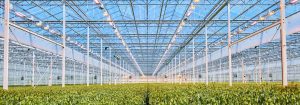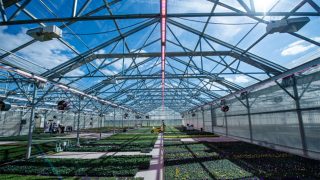Be the first! Get the latest news and updates - Subscribe to our newsletter!
8 choices to a cost-effective LED grow light
Smart design delivers longlasting performance - Part 1
To grow crops successfully and cost-effectively with LED grow lights, your LED system must be designed to perform reliably in the harsh conditions of your greenhouse environment. In part 1 of a 2-part series, we explain 4 smart design choices we’ve made for Philips GreenPower LED toplighting compact that give you peace of mind. With this proven design, your Philips LED lighting system is guaranteed to work reliably for many years and much more than 36,000 hours of intensive use, while being easy to maintain and clean.
Smart design #1: Aluminum body and passive cooling for better heat management
LED lighting generates much less heat than high pressure sodium (HPS) lighting, but it still generates heat. So the housing of your LED module needs to efficiently manage excess heat. Otherwise the light output of your LEDs will decrease dramatically. There are two choices to keep the LED module cool. Active cooling with water or a fan. Or passive cooling that uses the material of the housing to dissipate the heat from the LEDs. Signify opts for passive cooling because active cooling introduces extra parts to the product that can cause the LED system to fail. For instance, water cooling can leak and has to keep running to avoid algae formation even when lights are off, so it uses more energy.
That’s why we’ve used a cast aluminum body for our LED modules to create a heat sink. It has large cooling vents that promote air flow and make it easy to clean the module. Small vents can collect dust and moisture that lower the module’s cooling capacity and make it difficult to clean. Our large cooling vents let water easily run off during cleaning and reduce pool forming that can produce moisture in the product. The top of the module and all of the cooling vents are rounded to prevent moisture from standing.
The cast aluminum body has been milled to create a completely flat surface. The Metal Core Printed Circuit Board (MCPCB) is attached to that milled surface, but we still fill even the smallest spaces between the milled surface and the MCPCB to optimize the thermal resistance. In fact, the LED toplighting compact module has an IP66 ingress protection rating. This means it can withstand dust and water from coming in. The design of the toplighting compact thus ensures that the grow light delivers very high light output, consistently over time, while being easy to clean.
Smart design #2: Standard connector for easy, cost-saving switch to LED
The LED toplighting compact is designed with a Wieland connector and adapter that fits existing HPS connectors, so you can easily replace your HPS lighting with our LED lighting, using your existing HPS set-up and trellis. We use standard Wieland connectors because they are a dependable and proven product in the horticulture industry. In fact, 85% of our current HPS installations are also equipped with Wieland connectors. You can replace HPS with our LED lighting as long as the power load of the connection is not higher. For example, 1040 W HPS can be replaced by an LED product of max 1040 W without any problem. Because the LED module is mounted under the trellis the connector is placed on the side of the housing, allowing you to easily access and mount the cable or a splitter.
An important advantage of our LED toplighting compact is that it does not have an inrush current; this is the instant surge of current drawn by an electrical device when first turned on. That means you do not need to change your breakers when switching to the LED toplighting compact. Many LED products have high inrush currents that can overload a standard breaker, meaning you have to modify your circuit breaker cabinet to use them, which can be very costly.
Smart design #3: Driver in a separate compartment
When you turn the LED module on, the air around it warms up. And when you turn it off, the air cools down. You want to do this in a controlled manner, otherwise as the module cools down, moist air will be drawn into the module which can corrode electronic components over time. To prevent this, we’ve placed our driver in a separate compartment and sealed it with a gasket to create an enclosed component. A gore-tex vent on the compartment works just like self-breathing raincoat, allowing air to circulate but preventing moisture from coming in and depositing on the driver. Our drivers are developed in-house and meet the most stringent standards to protect against sulfur and safeguard electronic performance.
Smart design #4: Powder coating provides solid resistance to corrosion and flaking
Our aluminum body has a white powder coating. Why powder coating? Unlike paint which is very sensitive to chemicals, powder coating is applied electrostatically and then cured with heat or UV light making it much more robust. It costs slightly more, but pays for itself in the long run. Your powder-coated LED module resists chemicals used in the greenhouse that can erode paint and cause corrosion. It also looks great and no paint flakes fall off after a few years of use.
Read our second blog in this series, “8 choices to a cost-effective LED grow light - Smart design delivers longlasting performance”
Quality above everything
When developing a new product, we’re always looking at design aspects that can help make a grower’s business smarter, more efficient and more productive. This commitment to quality has made Philips LED lighting products the preferred choice for growers in over 43 countries because of the unrivalled quality and performance they deliver. With Philips GreenPower LED toplighting compact, you can rely on a proven product resulting from 15 years of experience and learnings in LED for horticulture applications. It helps you improve the quality and yield of your crops for a very long period of time to increase your return on investment.
Why partner with Signify?
You want to be sure to get a rapid return on your investment and have all aspects of your project carried out professionally. With Signify, your project is in experienced hands.
Signify is the global leader in the lighting sector and has built up a substantial track record in more than 400 projects in the horticultural lighting market since 1995. This includes over two decades of dedicated experience developing tailor-made, LED-based light recipes that help growers speed up growth, increase yield and improve the quality of plants. With cutting-edge LED innovations at our command, we can custom-build a science-based solution for you.

René van Wees
Global Manager Application Engineering
René van Wees started his career at Philips Research Laboratory in 1987 and joined Philips lighting in 2003 to help develop a first commercial LED product for signage. In 2006 he started working in the new area of LED for horticulture, has been there ever since. He enjoys working as the linking pin between customers and product development, giving trainings, gathering customer feedback and advising them on LED for their applications. He works with a 10-member team to provide the best possible technical support to customers worldwide.
Contact us
Contact certified partners
Philips products are sold through a global network of certified partners. Find partners in your region for more information about Philips LED grow lights.
Contact Philips
What are the best LED grow lights for your situation? We are here to help. Please use our form to submit your request.
Subscribe to newsletter
Keep up to date about Philips LED lighting in horticulture by subscribing to our newsletter.
Join our team
Interested in discovering your recipe for growth and joining our team? Take a look at our career page for more information.
Interested?
Learn more about LED lighting in horticulture by reading our latest articles and case studies.
Events
Fruit Logistica
Berlin, 5-7 February
Leamington Greenhouse Grower Expo
Leamington, 12 February
HortiContact
Gorinchem, 18-20 February
Blog
Dynamic LED lighting yields significant savings
With high energy prices here to stay, we’ve seen big changes in the way growers are thinking about their use of light.



